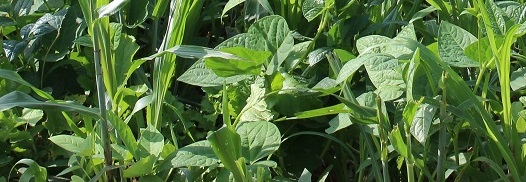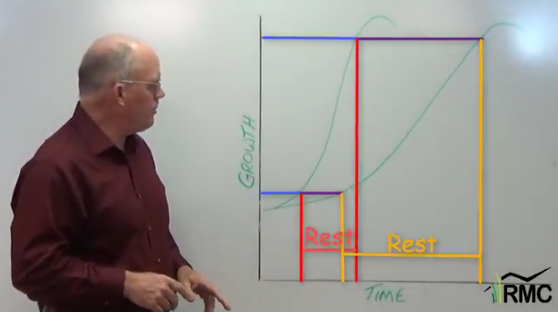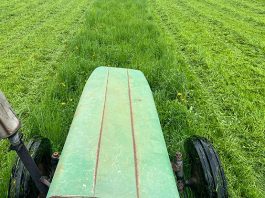Here’s a response from Genevieve at Kings Agriseeds for a reader who asked: “When can you start grazing a new planting? What if it’s an oats/peas combo, or some other mix? How do you know it’s good to graze? What is a good way to manage it?”
Timing to start grazing varies for each species and mix, as well as whether or not you plan to get regrowth out of the crop, what animal species you are grazing, and what your grazing system looks like. In general, you want to maximize the yield of this first grazing, without sacrificing quality and regrowth potential, but the exact balance of quality and yield will depend on your operation.
Quality

When managing for maximum yield at a high forage quality level, manage for the species that will lose quality the fastest as the mix matures. For many grass-legume mixes, this is the grass. For example, it’s the oats in a pea-oat mix, or the sorghum-sudan and millet in our Ray’s Crazy Summer Mix. As grasses get taller and begin to head out, the stem increases in lignin content, while fiber digestibility and protein take a nosedive. So the best approach is to look for the stage at which the primary grass in the mix is normally ready to graze. That’s flag leaf to boot stage for many grasses and small grains, and about waist high for warm season grasses like sorghum-sudan and millet. For cool season perennial grasses and tall growing legumes (alfalfa, alsike clover, birdsfoot trefoil, ladino clover, red clover), start grazing at 8-10 inches. Your goal will be the combination of yield and quality to suit your needs, and plants that have recovered sufficiently from the previous grazing.
Forget About Calendar Date
 While calendar date can be a helpful guide, it’s not as accurate as going out and checking for plant height and growth stage. Most biological activity is driven by thermal energy, not the date (although they frequently coincide). Each leaf takes a certain amount of heat units for the plant to produce so growth stage depends not so much on the date as on the amount of heat units (based on air temperature) the plant has experienced since it started to develop. Growth stage may also depend on day length, which is directly related to date.
While calendar date can be a helpful guide, it’s not as accurate as going out and checking for plant height and growth stage. Most biological activity is driven by thermal energy, not the date (although they frequently coincide). Each leaf takes a certain amount of heat units for the plant to produce so growth stage depends not so much on the date as on the amount of heat units (based on air temperature) the plant has experienced since it started to develop. Growth stage may also depend on day length, which is directly related to date.
Regrowth
When you start grazing depends a good deal on how much regrowth you expect and plan for from the crop. Some mixes are heavy on species that do not regrow well – such as Ray’s Crazy Mix, which contains a high percentage of cowpeas. Since cowpeas don’t regrow well, the regrowth of the mix as a whole would leave big gaps where weeds could move in. Therefore, with a mix like this, you want to plan for one big grazing. If it will be for a class of animals with lower nutritive needs, you can even wait a little longer, to maximize the yield you get out of that one grazing.
How long should you keep the animals on the pasture? The time of year determines this. For cool season annuals, recovery takes about 4 days in the prime growing season, May to June. In the season of slower growth, August to September, it will take about 10 days, so to avoid grazing the new growth, this recovery period can be used as a guide.
Grazing Style

Are you planning rotational grazing or one big graze? If the field will be broken into strips or paddocks, plan to start the rotation a little ahead of the target growth stage for the quality you want to achieve.
Rest Period
For the longevity of a perennial stand and the recovery potential of an annual stand, you want to avoid grazing too soon. Perennial stands need to develop photosynthetic capacity to restore depleted root reserves. Just as the first grazing depends mainly on the weather and temperature conditions driving initial growth, the length of rest period between one grazing and the next depends heavily on the time of year. Warmer weather means faster recovery.
If you intend to interseed legumes or other species, however, using shorter recovery periods, in combination with longer grazing times, is a great strategy to shock the stand back to reduce the competition for the new seeding. To take this approach, keep in mind that you will need to use lower classes of livestock with reduced nutritional needs, since the longer you keep them on the pasture, the lower the quality of forage they will be forced to graze.
Remember that higher stubble means quicker recovery. Summer annuals and winter small grains do well with a six inch residual, and perennial species should have at least a 3-4 inch residual.





Grazing new seedings with cattle – do a pull test, grab a handful of new growth and tear sideways like a cow would, if it shears off and there are no roots, it’s established well enough to graze. If we no till establish and don’t destroy soil structure, the new seeding is ready to graze sooner than when soil is worked.
If you’re using a cover crop of peas/oats or something. You would still want to do the same test, but now you’re also trying to manage light & moisture competition between the cover cop and longer term seeding underneath he canopy.
getting sunlight to the seeding sooner is better than waiting for highest yield from the peas/oats. More often than not I see producers waiting too long to start grazing, shade is no friend to new seedings.
Comments are closed.